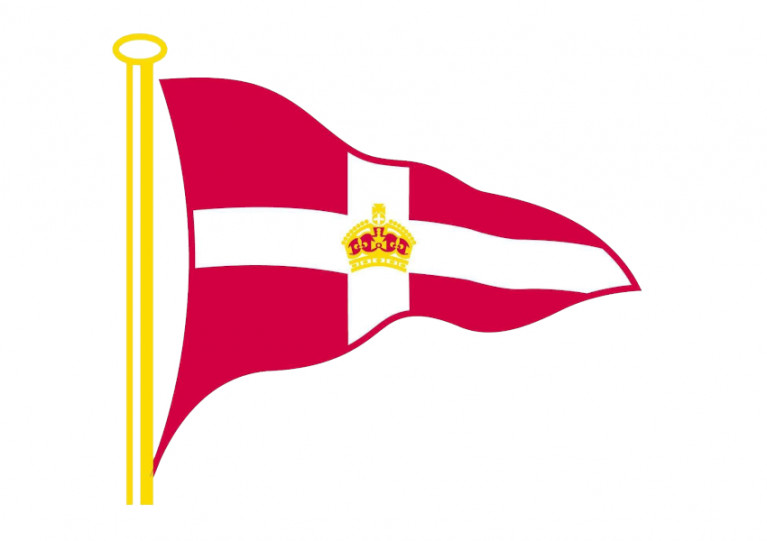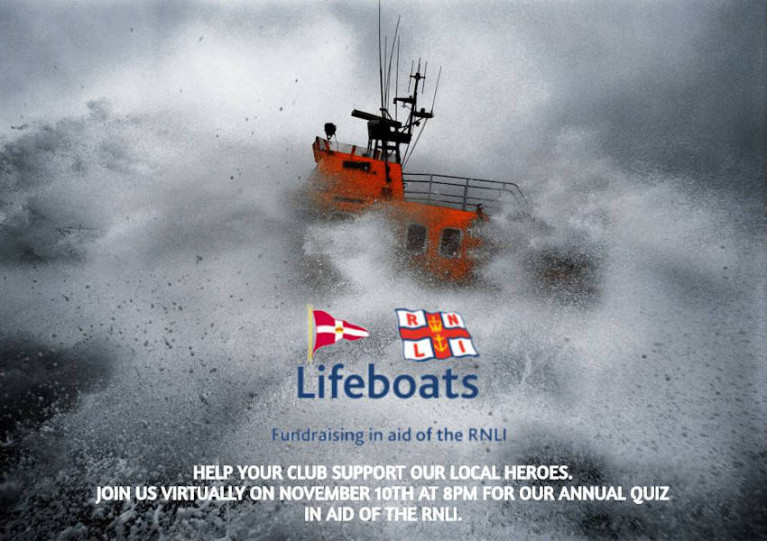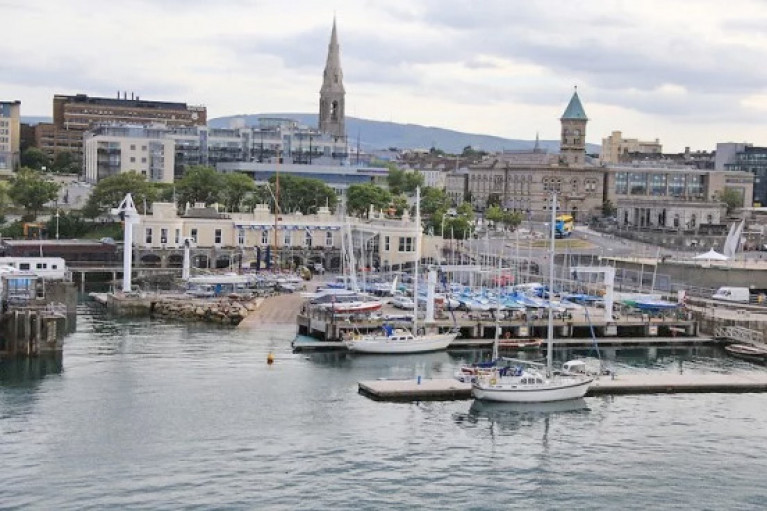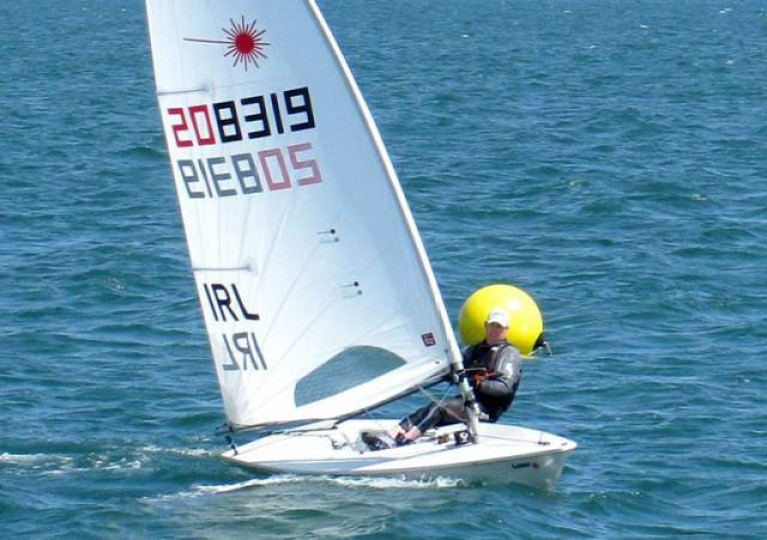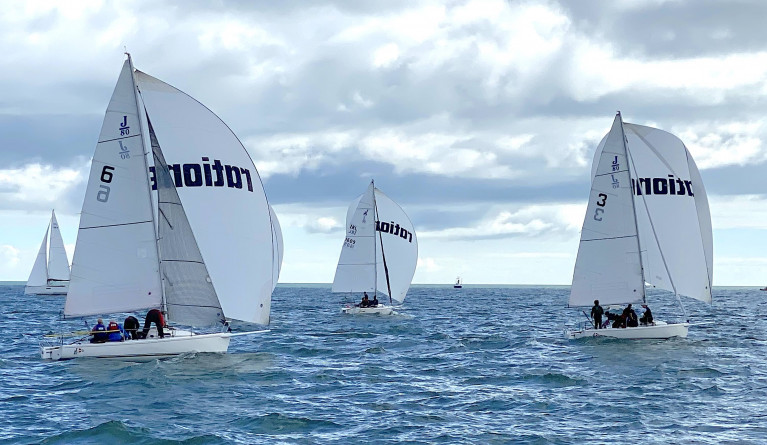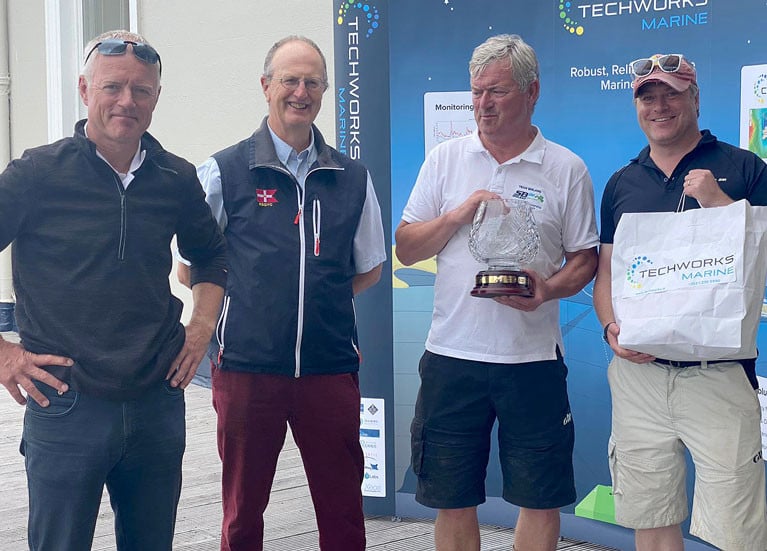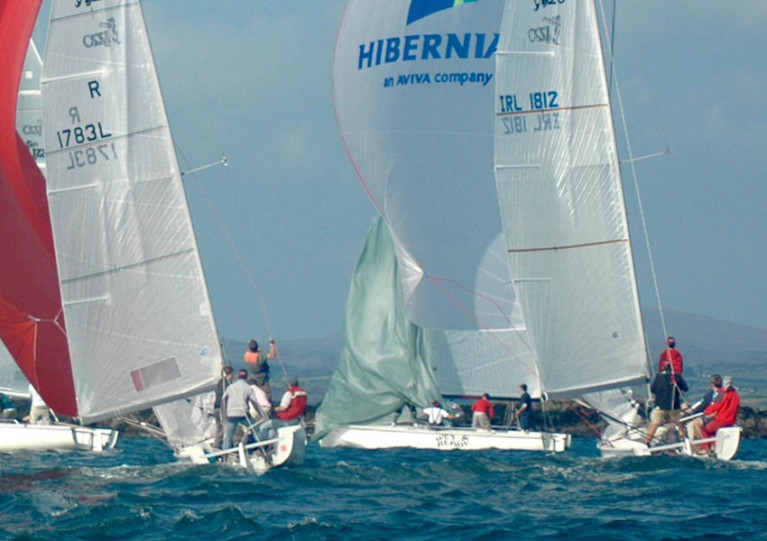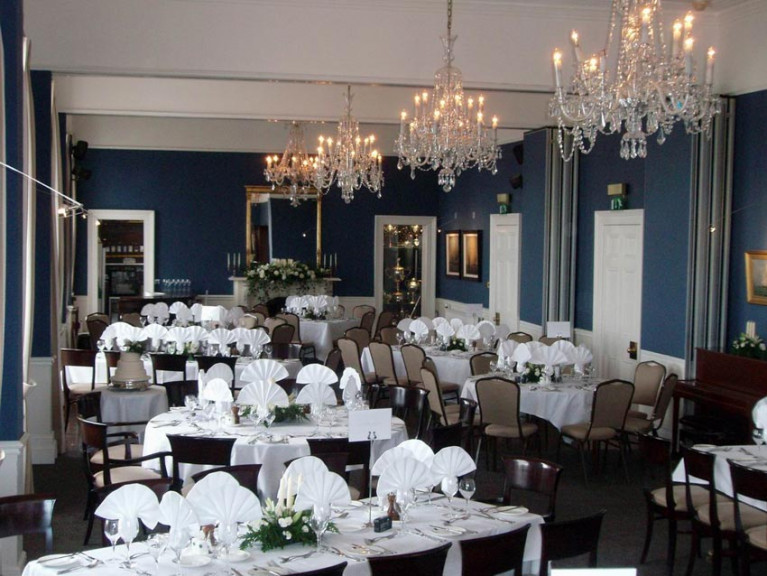Displaying items by tag: RStGYC
Larry Martin RIP
One of the most popular longtime sailors in Dublin Bay, former RStGYC Commodore Larry Martin, has died, and our sympathies are with his family and many friends afloat and ashore.
A full appreciation of his generously-lived life appears on Afloat.ie here
The Royal St George Yacht Club will host an online Zoom table quiz on Friday 26th March to raise funds for Rehab Care in Dun Laoghaire.
Join quizmaster Sarah Mullen-Rackow as she challenges with questions on an evening of fun and prizes that’s not to be missed.
Tables are €40 and the quizzing begins at 8 pm. Places are limited so be sure to book early to avoid disappointment.
For any queries contact Elle Flanagan at reception and marketing on 01 280 1811.
Register here
Royal St George Now Taking Orders for Deluxe Christmas Hampers
The Royal St George Yacht Club is now taking orders for its deluxe Christmas hampers.
Members can surprise their loved ones and friends this Christmas with a fantastic gift from their club, featuring a selection of preserves from Wexford Home Preserves, handmade sweet treats and more.
Hampers are €60 (€75 with a bottle of Prosecco) and are available for collection or delivery. To place your order click HERE.
Royal St George’s Annual Table Quiz For RNLI Zooms Ahead Online Next Tuesday Night
Some places remain for the Royal St George Yacht Club’s annual table quiz fundraiser for Dun Laogahire RNLI — this year taking place remotely via Zoom, and open to both club members and the public.
Join quizmaster Sarah Mullen-Rackow and host Mark Ridgway as they boggle your brains in aid of the RNLI from 8pm next Tuesday night 10 November, with fabulous prizes up for grabs.
Under the current Level 5 restrictions, the club will only accept teams of four representing a single household. The entry fee is €40 per team.
The online entry form can be found HERE, and any questions can be directed to Danielle at [email protected]
Dinghy Parking Updates From Dun Laoghaire Waterfront Clubs
Summer dinghy parking at the Royal St George Yacht Club in Dun Laoghaire ended this past Sunday 11 October, and all dinghies were expected to be removed by that date to facilitate the club’s annual lift-out.
A limited number of storage slots are available for those signed up for winter training and/or the DMYC Frostbite racing series, and anyone who has not yet done so is invited to apply HERE.
Temporary space has also been secured in the Old Ferry Terminal until Friday 30 October for boats that do not yet have a winter parking slot. Please note that you will need to bring over your own boat and collect it on the assigned dates.
Optimists are currently exempt from these requirements, but storage space is available — with preference given to those actively sailing, who will get the bottom racks.
Meanwhile, the neighbouring National Yacht Club is now taking applications for dinghy platform parking over the winter.
Dinghies taking part in either the junior training sessions or the Frostbite series must complete this form prior to bringing their boats back on the platform.
Boaters must note that platform parking does not reopen before Saturday 31 October as the boathouse still has to lift many keelboats on trailers and position them on the platform following the main lift-out scheduled for Saturday 24 October.
Royal St George Welcomes Laser Masters This Weekend
Update Friday 18 September: The Irish Laser Masters have been cancelled on the eve of the event after Dublin was moved into Level 3 of coronavirus restrictions. Afloat.ie has more on the story HERE.
The Royal St George Yacht Club welcomes the Laser class to Dun Laoghaire for their Masters Nationals this coming Saturday 19 and Sunday 20 September.
As previously reported on Afloat.ie, the event was one of he first to reschedule in the wake of coronavirus restrictions earlier this year.
And the current climate means that there will be no formal shoreside activities to accompany the weekend of racing.
The club will be making use of its Virtual Race Office, while competitors can connect via an event WhatsApp group, and any protest hearings will be held using the Zoom platform.
There will also be a virtual draw during the regatta for both Standard and Radial sailors, with two £100 vouchers for main sponsor Lennon Racewear up for grabs.
Visiting boats (any not currently on the RStGYC deck) are asked to contact the sailing office — 01 280 1811 ext 3 or [email protected] — in advance of planned arrival to ensure access to club facilities.
In other news, the Notice of Race and Sailing Instructions are now available for the Laser Munsters taking place on the weekend of 3-4 October at Kinsale Yacht Club.
Registration is open now, and the list of entrants already confirmed is also online.
Howth Yacht Club's Mojo Crew Win J80 National Championship at Royal St. George Yacht Club
Howth's Patrick O' Neill and the crew of Mojo were crowned J80 Irish National Champions at the Royal St. George Yacht Club this afternoon after a closely fought seven-race series on Dublin Bay.
14 boats competed from four different Dublin clubs that represent a building momentum for the Irish J80 class, one of the world's most popular sportboats.
In a show of strength for Howth Yacht Club entries, four of the top five places were taken by the North Dublin visitors but O'Neill's overall victory was ultimately only by the slender margin of half a point from host club runner up Jonny O'Dowd. In third place overall was 1996 Olympian Dan O'Grady sailing Jammy.
Four race wins on Saturday put O'Neill in a strong position overnight and even two protests in the final racers on Sunday could not stop the Mojo challenge.
 1st Mojo IRL 1551 Howth Yacht Club Patrick O' Neill
1st Mojo IRL 1551 Howth Yacht Club Patrick O' Neill
 2nd JABS IRL 1609 Royal St George Yacht Club Jonny O' Dowd
2nd JABS IRL 1609 Royal St George Yacht Club Jonny O' Dowd
J80 National Championships 2020 Results at the Royal St. George Yacht Club (Top Five)
1st Mojo IRL 1551 Howth Yacht Club Patrick O' Neill
2nd JABS IRL 1609 Royal St George Yacht Club Jonny O' Dowd
3rd Jammy IRL 1097 Howth Yacht Club Dan O' Grady
4th Red Cloud 985 Howth Yacht Club Darragh O' Connor
5th Headcase 1651 HYC, MSC, BYC, LRYC Ryan Glynn
Full results are here
The SB20 class were overwhelmed by an enthusiastic response from Techworks Marine to sponsor this first event of the season, for which the class are very appreciative, and the marine data company were represented on the water by CEO, Charlotte O’Kelly helming the only all-girl team this weekend.
Team George with Sailing Manager Ronan Adams, Darius in the boathouse and Jamie in the dining room, smoothly facilitated the first COVID event in the club this year.
We are living in a different world now with online registration, Covid declarations, updated SOPs and a virtual briefing. SB20 veteran RO Barry O’Neill did the honours with his ‘pod’ team and RSGYC mark layers. The George managed a thoroughly enjoyable event, while ensuring safety protocols were observed both afloat and ashore.
Saturday’s forecast had us all armed with factor 50 and water as we headed out to the race area, near the anchorage as we competed for space with DBSC racing and the Fireball Nationals. A breeze of 5-7 knots, occasionally gusting 10, and a strong flooding tide proved challenging, and although the day was warm, with wind direction fairly consistent from a NE direction, sadly no sea breeze developed.
The first two races of the WW/LW course became drag races out to the right, but the fleet split in the slack tide for the final race of the day. There was just one general recall, with the fleet consistently on the line, battling for spots all weekend. After racing, we withdrew to the balcony for post mortem and drinks before a delicious dinner in the dining room.
As Afloat reported previously, overnight there were just two points separating the top three boats Ted, SoBlue and Bád, so umpires Ailbe and Eunice stepped up to ensure the lead boats behaved. Racing was closer to the harbour, and a stronger breeze split the fleet across the race area both up and downwind.
SoBlue NYC won the first race on Sunday, and Bád the second. With one more race to go, the top three boats were on just 7 points apiece.
The final two lap race had CM Provident with John Malone, Emmet Sheridan and Luke Johnson from LRYC led the fleet around the weather mark, followed by TED, Bád in fourth and SoBlue lying 6th. Ted took the lead down the run with an 8 boat lead over Bád in second up the second beat.
A 25-degree shift up the second beat brought Doran’s LoFly back into contention and Bád sneaking ahead of Ted at the WW mark. A nip and tuck down the last run of the weekend, resulted in SoBlue now chasing hard and lying fourth behind LoFly. Bád held onto their lead of about 3 boat lengths with a split at the final gate. SoBlue headed for the left gate and Ted and Soblue went for the right.
With just a 300m beat to the finish, Bád tacked to cover, while Ted and SoBlue benefited from more breeze on the left side of the short leg to the finish. A tacking duel ensued between Bád and Ted but Bád had enough in the bag to cross one boat length ahead of Ted, taking the title by a point, SoBlue took fourth place in the race, just 2 or 3 boat lengths behind, securing third place overall.
Provident CRM took the Silver fleet trophy home to Lough Ree.
In a competitive fleet where one error can cost so dearly, the two additions to the fleet (Bango from a burgeoning fleet in LRYC and Tiger Light from the RIYC) were doing well to keep in sight of the pack at all, and showed promise in the mix at times.
A socially distanced prize giving took place on the balcony with RSGYC Commodore Peter Bowring doing the honours and a short speech regarding the 2023 Worlds coming to the NYC by SB20 Council World President, Jerry Dowling.
The next SB20 event is in NYC on the 5/6th September and the SB20 Nationals will take place in Lough Ree on 18-20th September.
This week the Royal St George Yacht Club is running its 1720 Sportsboat clinic starting tomorrow, Tuesday 4 August.
The four-day clinic will run from 9am-12pm each morning until Friday and is geared at introducing the excitement of big boat sailing, and helping sailors transition from dinghies into keelboat sailing.
Sailors must be at an ‘improving skills’ level and should be comfortable with tacks, gybes, beats and runs and be able to efficiently sail a course in a dinghy.
The training will have a heavy focus on basic keelboat theory, kite work, rigging, and racing tactics/strategy. The coaches will be on board to help give a full experience.
The clinic fee is €175 per person and bookings can be made online HERE.
Places are also available for next week’s team racing clinic (five mornings from Monday 10 August, €175) and the weekly Sea Tigers for ages eight and up (10am-1pm weekdays, €160 with own boat, plus €200 to rent boat and gear inc deposit).
Dun Laoghaire waterfront yacht clubs are preparing for their long-awaited reopening to members this week after the latest relaxing of coronavirus restrictions.
The National Yacht Club will throw open its doors to members from tomorrow, Tuesday 30 June, with revised opening and closing times to adhere to Government guidelines.
The clubhouse will be closed on Mondays but will be open from 10 am to 10 pm Tuesday to Saturday, with the clubhouse closing at 6pm on a Sunday.
Tea, coffee and scones will be available Tuesday to Sunday from 10.30am. Food service will run all day from 12pm to 8pm Tuesday to Saturday and Sunday lunch will be served from 12pm to 4pm.
Members will need to reserve a table by phoning the club on 01 280 5725 or by email to [email protected] [email protected] or [email protected]
The dining room will operate a strict two-metre social distancing regime which will be reflected in a maximum capacity of 50 persons.
The Bar will operate strictly in compliance with current regulations while the JB room will cater for pods and smaller group and also with a maximum capacity overall of 50 persons.
Once you enter the club you will be greeted and asked to sanitise your hands and to sign in (only the lead member of the booking need sign in), with an optional temperature check. You will then be shown to your table.
Alcohol will be strictly to table bookings only. There is no alcohol permitted in the Snooker Room, again in line with Government regulations.
Each table will be cleaned down and sanitised after use, and surfaces throughout will be sanitised, with bathrooms cleaned four times per hour.
Royal St George Yacht Club
Meanwhile, the Royal St George Yacht Club reopens its clubhouse for lunch at 12.30pm this Wednesday 1 July.
The club will comply with current guidelines regarding social distancing, contact tracing and an enhanced hygiene regime. A simple ‘one way’ circulation system will be in operation.
And as with the NYC, alcohol will only be served with meals, and bookings must be made in advance (up to 11am on day of booking). For full details see the RStGYC website HERE.




























